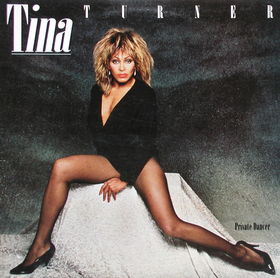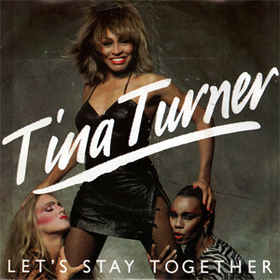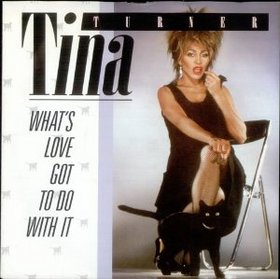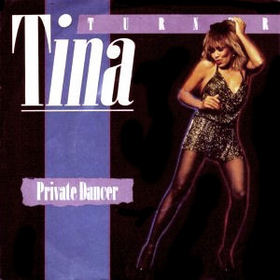Classic album revisited: Tina Turner’s “Private Dancer”
 By the dawn of the 80s, as the MTV generation was about to awaken, Tina Turner was seen as a relic from an earlier generation. Oh, her music and her legendary live performances weren’t forgotten — the work she did with her husband Ike Turner still resonated — but it was “oldies” music. The press was more interested in the shocking details of her years of torment at the hands of her husband, her dramatic escape from his clutches, and their bitter and acrimonious divorce proceedings. After her harrowing escape from their brutally abusive marriage in 1976, Tina tried to resuscitate her career with minimal success. She performed in Vegas, was a regular guest on variety TV shows, and toured regularly — but she wasn’t able to make a dent on the charts, and radio wasn’t interested in what she had to offer. She was a legend at the time of her peak, sure, but those years had long past. Tina’s first album without the input of her ex-husband was 1978’s “Rough,” a disparate combination of rock, R&B and disco that was widely ignored. She followed that with “Love Explosion” in 1979, a much more heavily disco-influenced album that also sank without a trace. Although she continued touring with some degree of success with her Vegas-style show, relying heavily on her old hits like “River Deep, Mountain High” and “Proud Mary,” her career was going nowhere.
By the dawn of the 80s, as the MTV generation was about to awaken, Tina Turner was seen as a relic from an earlier generation. Oh, her music and her legendary live performances weren’t forgotten — the work she did with her husband Ike Turner still resonated — but it was “oldies” music. The press was more interested in the shocking details of her years of torment at the hands of her husband, her dramatic escape from his clutches, and their bitter and acrimonious divorce proceedings. After her harrowing escape from their brutally abusive marriage in 1976, Tina tried to resuscitate her career with minimal success. She performed in Vegas, was a regular guest on variety TV shows, and toured regularly — but she wasn’t able to make a dent on the charts, and radio wasn’t interested in what she had to offer. She was a legend at the time of her peak, sure, but those years had long past. Tina’s first album without the input of her ex-husband was 1978’s “Rough,” a disparate combination of rock, R&B and disco that was widely ignored. She followed that with “Love Explosion” in 1979, a much more heavily disco-influenced album that also sank without a trace. Although she continued touring with some degree of success with her Vegas-style show, relying heavily on her old hits like “River Deep, Mountain High” and “Proud Mary,” her career was going nowhere.
Tina’s signing with manager Roger Davies turned out to be a key turning point. He helped refine her live act, changing it from a 70s-style costume-heavy review inspired by variety shows to a more straightforward, stripped-down rock set. It worked, and her live performances started generating buzz. Davies booked her at a series of key clubs like The Ritz, where stars lined up to see her. She landed a gig opening a few nights for the Rolling Stones on their tour in support of the massively successful “Tattoo You” album. Tina started getting some great press for her live performances.
Despite all this new momentum, a record deal remained elusive. It was a fortunate chance encounter with two new-wavers from Britain that would eventually start the path that led to Tina Turner’s spectacular comeback album, “Private Dancer.” Martyn Ware and Ian Craig Marsh were early champions of electronic music and original members of The Human League. They clashed with Human League vocalist Phil Oakey over his desire for a more commercial sound, and they ended up leaving the band in 1980 (prior to The Human League’s major success with the “Dare” album and their iconic single “Don’t You Want Me”). The duo would go on to form the core of Heaven 17, and they worked together on a number of other projects. One of them, released under the name B.E.F. (British Electronic Foundation), was a compilation called “Music of Quality and Distinction Volume One,” which featured various artists recording classic R&B tunes. They invited Tina Turner to record The Temptations’ “Ball of Confusion,” and she delivered a powerhouse vocal performance. Featuring an edgy new wave, synthesizer-heavy approach, it was a different, new, exciting sound for Tina. “Ball of Confusion” was released as a single and became a substantial hit in parts of Europe. It proved to be the spark Tina needed, and the template for how to bring her into the modern era. The success of “Ball of Confusion” drew the attention of Capital Records A&R man John Carter, and despite strong doubts by upper-level management at Capital, he signed her to a record deal.
Tina continued to tour while also recording a variety of material in search of the right single and material to formulate her first album for Capital Records. She recorded a handful of tracks with John Carter overseeing the sessions, including a searing cover of The Animals “When I Was Young,” a strutting version of The Motels’ “Total Control” (which would eventually wind up on the “We Are the World” benefit album), and the track “Rock ‘n Roll Widow” which at one point was mooted as a possible single (she performed it, along with future “Private Dancer” album track “Steel Claw” on the Johnny Carson show in 1982, two years before the album’s eventual release. “Rock ‘n Roll Widow” would eventually end up as the b-side to “What’s Love Got to Do With It,” and several other tracks recorded during this period were included on the expanded reissue of “Private Dancer” that was released in the late ‘90s).
She also recorded several additional covers with Martyn Ware and Ian Craig Marsh: they tried Sam Cooke’s “A Change is Gonna Come” and “Having a Party” and two by Al Green: “Take Me to the River” and a stunning version of “Let’s Stay Together.”
 Tina Turner’s recording of “Let’s Stay Together” with Ware and Marsh was the comeback single she had been waiting for. A slow-grooving alchemy of new wave, disco and sensual R&B, Tina delivered a knockout vocal on the first take. Released as a single in late 1983 in the UK and in January 1984 in the US, “Let’s Stay Together” began a slow ascent up the charts and eventually landed at #26 on the Billboard Hot 100, #3 on the R&B Chart, and it hit the top of the American Dance Chart. It was her first hit in America since “Nutbush City Limits” over a decade earlier. The song also did well in the UK, reaching #6. Tina Turner was back.
Tina Turner’s recording of “Let’s Stay Together” with Ware and Marsh was the comeback single she had been waiting for. A slow-grooving alchemy of new wave, disco and sensual R&B, Tina delivered a knockout vocal on the first take. Released as a single in late 1983 in the UK and in January 1984 in the US, “Let’s Stay Together” began a slow ascent up the charts and eventually landed at #26 on the Billboard Hot 100, #3 on the R&B Chart, and it hit the top of the American Dance Chart. It was her first hit in America since “Nutbush City Limits” over a decade earlier. The song also did well in the UK, reaching #6. Tina Turner was back.
With no album to promote, and momentum building at a feverish pitch, the rush was on. Suddenly the previously reticent Capital Records wanted an album, and they wanted it pronto. Roger Davies and Tina decided to record in England, where they were already working with Ware and Marsh, and a number of other cutting-edge, talented producers were available. They wanted the album to have an edgy, modern feel that merged the electronic/R&B hybrid work she’d been doing with Ware and Marsh and a more straightforward rock and new wave approach.
With “Let’s Stay Together” already in the can, they assembled a set of material and producers, and the album began to take shape. British producer Terry Britten was brought in to work on several tracks. He was a songwriter of note (he penned dozens of hits over his career), and had collaborated on a track with Scottish songwriter Graham Lyle that he thought was perfect for Tina. Like many of the songs that ended up on “Private Dancer,” “What’s Love Got To Do With It” had been sitting around for quite a while. It had been intended for Cliff Richard, a huge star in England and a frequent collaborator with Britten, but he chose not to record it. Britten shopped it around to other artists, offering it to Donna Summer and Phyllis Hyman with no luck. Tina herself was initially reluctant to record the track, but she finally relented, and a classic was born.
 The “Private Dancer” album and the “What’s Love Got To Do With It” single were released nearly simultaneously at the dawn of the summer of ’84. “What’s Love Got to Do With It,” a catchy, reggae-tinged number with a vocal that Tina delivered with real soul and feeling, rocketed up the charts. Helped along by a memorable video that received substantial MTV support, “What’s Love Got to Do With It” hit #1 in the US in early September and stayed lodged at the top for a full 4 weeks. It was Tina’s first ever #1 single in the US, and paved the way for the “Private Dancer” album to become a worldwide smash. It hit #3 on the Billboard Album Charts and went platinum in the US five times over.
The “Private Dancer” album and the “What’s Love Got To Do With It” single were released nearly simultaneously at the dawn of the summer of ’84. “What’s Love Got to Do With It,” a catchy, reggae-tinged number with a vocal that Tina delivered with real soul and feeling, rocketed up the charts. Helped along by a memorable video that received substantial MTV support, “What’s Love Got to Do With It” hit #1 in the US in early September and stayed lodged at the top for a full 4 weeks. It was Tina’s first ever #1 single in the US, and paved the way for the “Private Dancer” album to become a worldwide smash. It hit #3 on the Billboard Album Charts and went platinum in the US five times over.
The next single was the rock/new-wave hybrid “Better Be Good To Me.” Written by prolific songwriters Mike Chapman, Holly Knight and Nicky Chinn, the track was another one that had been sitting around for a while before landing in Tina’s lap. Holly Knight’s band Spider had recorded the track several years earlier, but it didn’t gain any traction. Producer Rupert Hine, who was coming off substantial success with The Fixx’s “Reach the Beach” album and their cutting-edge single “One Thing Leads To Another,” was brought in to produce a couple tracks for the album, including “Better Be Good To Me.” He enlisted members of The Fixx, including guitarist Jamie West-Oram and vocalist Cy Curnin, and Tina delivered yet another stunning, passionate vocal. A song of defiance that tied into her life story perfectly, “Better Be Good To Me” kept Tina’s momentum building and became a Top 5 hit in the US. She had proven that she could hit with an R&B dance song, a pop song, and now an edgy rock track.
 The title song became the next single. Released in late October, “Private Dancer” featured a striking video with Tina as a jaded ballroom dancer. The song was produced by John Carter and written by Dire Straits front-man Mark Knopfler. It was a leftover track from their previous album “Love Over Gold,” as Knopfler felt the song should be sung from a female perspective and they only recorded an instrumental. Dire Straits (minus Knopfler, whose guitar part was played by Jeff Beck) were brought in to record the song. The long, moody, sensual track became one of Tina’s signature songs. Featuring a terrific sax solo by British musician Mel Collins (who had also performed the famous sax solo on the Stones’ “Miss You”), it became another Top 10 hit in the US and reinforced Tina Turner’s incredible ability as a vocalist — nobody can deliver a line like Tina. She infuses just the right phrasing for the moment, the right amount of drama and passion: “Deutchmarks or dollars, American Express will do nicely, thank you! Let me loosen up your collar… Tell me, do you want to see me do the shimmy again?” It’s impossible to imagine anybody but Tina delivering those classic lines.
The title song became the next single. Released in late October, “Private Dancer” featured a striking video with Tina as a jaded ballroom dancer. The song was produced by John Carter and written by Dire Straits front-man Mark Knopfler. It was a leftover track from their previous album “Love Over Gold,” as Knopfler felt the song should be sung from a female perspective and they only recorded an instrumental. Dire Straits (minus Knopfler, whose guitar part was played by Jeff Beck) were brought in to record the song. The long, moody, sensual track became one of Tina’s signature songs. Featuring a terrific sax solo by British musician Mel Collins (who had also performed the famous sax solo on the Stones’ “Miss You”), it became another Top 10 hit in the US and reinforced Tina Turner’s incredible ability as a vocalist — nobody can deliver a line like Tina. She infuses just the right phrasing for the moment, the right amount of drama and passion: “Deutchmarks or dollars, American Express will do nicely, thank you! Let me loosen up your collar… Tell me, do you want to see me do the shimmy again?” It’s impossible to imagine anybody but Tina delivering those classic lines.
A couple more singles followed. The American market got the straightforward blues-rocker “Show Some Respect,” another Terry Britten composition and production. It was a minor hit in the US when it was released in early ’85. The rest of the world got another Terry Britten-produced track, Tina’s cover of Ann Peebles’ 1973 R&B hit “I Can’t Stand the Rain.” Built around a simple, repetitive looping keyboard riff and augmented by synthesizer bursts, it was another terrific performance and a great song-choice for Tina.
“Private Dancer” is best known for its classic singles, but there really isn’t a weak cut on the album. The finest moment on the album may be its opener, the hard rocking “I Might Have Been Queen (Soul Survivor)”. One of the few tracks written specifically for the album, the lyrics were penned by songwriter Jeanette Obstoj (who would go on to co-write several tracks with The Fixx, including their hit “Secret Separation”) and the music by producer Rupert Hine and guitarist Jamie West-Oram of The Fixx, who would also perform on the song. It’s a remarkable track. Listen to the bridge, starting at the 2:28 point, as it slowly builds intensity and power until the song’s dramatic emotional release at the 3:04 point as Tina belts out defiantly “Oh, I’m a Soul Survivor!” Indeed she is.
Along with their previously recorded “Let’s Stay Together,” Tina recorded another cover with the duo of Marsh and Ware: a dramatic take on David Bowie’s nugget from the “Diamond Dogs” album, “1984.” John Carter produced the frenetic rocker “Steel Claw,” a song written by acclaimed Irish songwriter Paul Brady that Tina had been performing in her live show for some time. “Steel Claw” features one of the best vocal deliveries on the album — her phrasing is dead-on, wickedly perfect.
“Private Dancer” is nothing less than the epitome of a phoenix rising from the ashes. Forgotten and forsaken, reduced to performing her old hits in Vegas-style reviews and appearing on cheesy TV shows, Tina Turner deserved far better. Her legacy of remarkable R&B and rock recordings with her husband Ike is legendary, and her perseverance and strength in escaping her hellish nightmare with him was so extraordinary that it was turned into a major feature film, the acclaimed “What’s Love Got To Do With It” starring Angela Bassett. “Private Dancer” remains one of the most important albums of the decade. It would garner four Grammy Awards: Record of the Year, Song of the Year, and Best Female Pop Vocal Performance for “What’s Love Got to Do With It” and Best Female Rock Vocal Performance for “Better Be Good To Me.” That night at the 1985 Grammy Awards belonged to Tina. Her appearance on stage in a stunning red dress to perform “What’s Love Got to Do With It” was a significant moment of triumph that was lost on nobody who was watching. From escaping an abusive marriage by checking into a hotel room, all alone, with no money — to being the Queen of the Ball at the Grammy’s, performing her #1 signature song in front of rock royalty and millions of fans… quite a journey. “Private Dancer” shouldn’t have worked, but somehow it did. The material on it came from disparate sources — covers, songs that had been passed on by other artists, some new material — by various songwriters and producers. But it had terrific songs, a talented group of producers and musicians, and, most importantly, what tied it together and made it gel into a cohesive album was Tina herself. Her sheer presence, the power of her vocal delivery and interpretation, and the overriding endurance and strength in the face of obstacles that would have been impossible for most to overcome infused the album. Once she hit with “Let’s Stay Together” and released a killer single in “What’s Love Got To Do With It,” the media, critics and fans were all on her side. Her story was so compelling, her music so extraordinary, her performances so kinetic and fearless – – everyone wanted her to be successful. She was an inspiration, and remains so to this day.
Released when she was 44 years old, “Private Dancer” would launch a second, far more successful and long-lasting career for Tina. She would go on to score more major hits over the years: “We Don’t Need Another Hero” from the film “Mad Max Beyond Thunderdome,” in which Tina delivered a knockout performance as Aunty Entity, “Typical Male”, “What You Get is What You See,” “The Best,” “Steamy Windows,” “Goldeneye” from the James Bond film of the same name, and “I Don’t Wanna Fight” just to name a few. She’s continued recording and performing, and is an undisputed musical legend. Now 73, her public appearances have started to slow in recent years, but she toured as recently as 2008-2009 with a set of dates billed as “Tina! 50th Anniversary Tour.” “Private Dancer” is the album that set all of these things in motion, and brought Tina Turner the stature and success that she deserved — and when it comes down to it, we can all thank former Human League and Heaven 17 members Martyn Ware and Ian Craig Marsh for providing the spark that led to “Let’s Stay Together,” which started the whole transformation. A remarkable album, an even more remarkable story. Tina Turner’s “Private Dancer” is the greatest comeback album in rock and roll history.
Support Metro Weekly’s Journalism
These are challenging times for news organizations. And yet it’s crucial we stay active and provide vital resources and information to both our local readers and the world. So won’t you please take a moment and consider supporting Metro Weekly with a membership? For as little as $5 a month, you can help ensure Metro Weekly magazine and MetroWeekly.com remain free, viable resources as we provide the best, most diverse, culturally-resonant LGBTQ coverage in both the D.C. region and around the world. Memberships come with exclusive perks and discounts, your own personal digital delivery of each week’s magazine (and an archive), access to our Member's Lounge when it launches this fall, and exclusive members-only items like Metro Weekly Membership Mugs and Tote Bags! Check out all our membership levels here and please join us today!






















